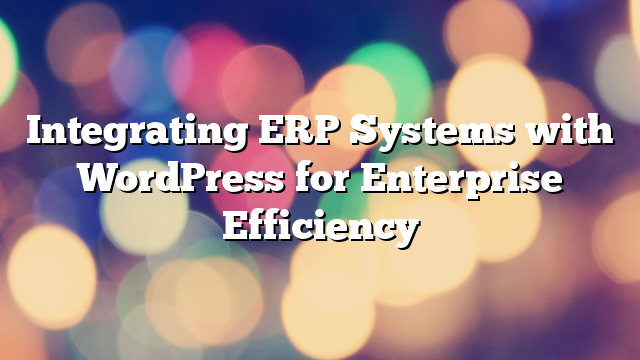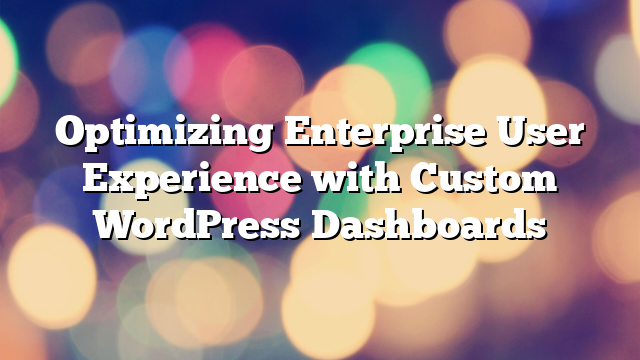Implementing Security Best Practices in WordPress for Enterprise Websites
12.11.2024

WordPress is a popular choice for enterprises worldwide, but with its popularity comes the need for robust security measures. Cyber threats target enterprise websites frequently, and a breach could lead to significant financial and reputational damage. Implementing best practices for WordPress security is essential to protect sensitive data, maintain website uptime, and comply with regulatory standards. This article explores proven strategies for securing enterprise WordPress websites, ensuring that they are resilient to modern threats.
Why Security is Crucial for Enterprise WordPress Sites
Enterprise websites often handle a large volume of sensitive data, including customer information, financial records, and proprietary business content. A security lapse in a WordPress website can lead to data breaches, financial losses, and loss of customer trust. Moreover, compliance with data protection regulations, such as GDPR and CCPA, requires companies to take appropriate measures to secure user data. Therefore, strengthening the security of your WordPress website is vital for both protecting your business and meeting regulatory obligations.
Key Security Best Practices for Enterprise WordPress Websites
1. Use a Secure Hosting Provider
The foundation of any secure website is a secure hosting environment. Choose a hosting provider that offers advanced security features like firewalls, malware scanning, DDoS protection, and automated backups. Many managed WordPress hosts also provide server-level security, specifically optimized for WordPress, ensuring enhanced protection against common threats. A reliable host is a critical first step in safeguarding your enterprise website.
2. Keep WordPress Core, Plugins, and Themes Updated
Outdated software is one of the most common vulnerabilities exploited by hackers. Regularly updating WordPress core, plugins, and themes is essential to protect against known security flaws. Many security patches are released to address vulnerabilities, and running outdated versions of software exposes your site to potential attacks. For enterprise sites, setting up automatic updates for security releases and scheduling regular update checks can help maintain a strong defense.
3. Implement Strong Passwords and Two-Factor Authentication (2FA)
Weak passwords are a common gateway for attackers. Enforce a strong password policy across all user accounts on your WordPress site to mitigate this risk. Additionally, implementing two-factor authentication (2FA) adds an extra layer of security, requiring users to verify their identity through a second device or application. Popular 2FA plugins, such as Google Authenticator or WP 2FA, are compatible with WordPress and can be easily configured to protect your login process.
4. Limit Login Attempts and Use CAPTCHA
Brute-force attacks involve repeatedly attempting to guess login credentials until the correct combination is found. Limiting login attempts can prevent attackers from guessing passwords. By using a plugin like Limit Login Attempts Reloaded, you can specify how many times a user can attempt to log in before being temporarily locked out.
Additionally, implementing CAPTCHA on your login page can help prevent automated bots from executing brute-force attacks. Services like Google reCAPTCHA are easy to integrate with WordPress and offer effective protection against bot traffic.
5. Use SSL Certificates and HTTPS
SSL (Secure Socket Layer) certificates encrypt data transmitted between your website and its users, preventing attackers from intercepting sensitive information. SSL is essential for any website that handles sensitive data, such as login credentials and payment information. Enabling HTTPS also signals to search engines and users that your site is secure. Many hosting providers offer free SSL certificates through services like Let’s Encrypt, making it easy to implement on your WordPress site.
6. Regularly Back Up Your Website
Backups are essential for recovering from security incidents, such as hacks or data loss. Regularly backing up your WordPress site ensures that you can restore it to a previous state if necessary. For enterprise websites, daily backups are often the standard, with multiple backup versions retained for redundancy.
WordPress backup plugins like UpdraftPlus or BackupBuddy offer automated backup solutions, including cloud storage options for added security. Many managed hosting providers also provide daily backups as part of their service, making it easier to recover from unexpected events.
Advanced Security Measures for WordPress Enterprise Sites
1. Implement Web Application Firewalls (WAF)
A Web Application Firewall (WAF) monitors and filters HTTP traffic to prevent malicious activity. WAFs can block a wide range of threats, including SQL injection, cross-site scripting (XSS), and malware. Enterprise websites can benefit from WAF services like Sucuri, Cloudflare, or Wordfence, which offer real-time threat detection and blocking capabilities. A WAF can be configured to protect your WordPress site from known vulnerabilities and provide an additional security layer.
2. Conduct Regular Security Audits
Security audits are essential for identifying vulnerabilities in your website’s infrastructure, code, and configurations. For enterprise WordPress websites, scheduling regular security audits can help detect and address potential issues before they are exploited. Audits can include scanning for malware, checking for outdated software, reviewing user access levels, and inspecting custom code for weaknesses.
Many security plugins, such as Wordfence and iThemes Security, offer automated security scanning, while specialized services like WPScan provide vulnerability reports tailored to WordPress.
3. Harden WordPress Configuration Files
Modifying certain WordPress configuration files can enhance the security of your website. For example:
- Disable File Editing: By adding
define('DISALLOW_FILE_EDIT', true);to yourwp-config.phpfile, you can prevent users from editing files in the WordPress dashboard, reducing the risk of unauthorized code changes. - Change Database Prefix: WordPress uses a default table prefix (
wp_) that attackers often target. Changing this prefix to something unique can make SQL injection attacks more difficult. - Disable Directory Indexing: Disabling directory browsing prevents attackers from viewing the contents of folders on your server. Add
Options -Indexesto your.htaccessfile to disable this feature.
These configurations can provide an additional layer of protection against unauthorized access and data breaches.
4. Implement Role-Based Access Control
Enterprise websites often involve multiple users with varying roles and responsibilities. Implementing role-based access control (RBAC) ensures that users only have the permissions they need to perform their tasks. For example, administrative privileges should be restricted to trusted personnel, while other users should be assigned editor or author roles as appropriate.
By minimizing the number of users with administrative access, you can reduce the risk of accidental or malicious changes that could compromise site security. Using plugins like User Role Editor allows you to customize user permissions and roles to meet the needs of your enterprise.
Maintaining Security Through Ongoing Monitoring and Updates
1. Enable Real-Time Monitoring
Real-time monitoring of your WordPress website can help you detect and respond to security incidents immediately. Security plugins such as Wordfence and Sucuri provide monitoring services that alert you to suspicious activities, such as unauthorized login attempts or file changes. Real-time alerts allow your security team to investigate and respond to potential threats before they escalate.
2. Educate Users on Security Practices
A website’s security is only as strong as its weakest link, which is often human error. Educating users on security best practices, such as recognizing phishing emails, avoiding suspicious links, and using strong passwords, can reduce the risk of successful attacks. Regular training sessions for employees and contributors can reinforce the importance of security practices and minimize human-related vulnerabilities.
3. Review and Update Security Policies Regularly
Enterprise websites should have clear security policies that define roles, responsibilities, and procedures for handling security incidents. Regularly reviewing and updating these policies ensures that they align with the latest best practices and threat intelligence. By fostering a security-conscious culture, enterprises can better protect their WordPress websites and respond swiftly to potential threats.
Conclusion
Securing an enterprise WordPress website is an ongoing process that requires a multi-layered approach. From implementing basic security measures like strong passwords and SSL certificates to advanced protections such as WAFs and real-time monitoring, there are many strategies to safeguard your website against threats. By investing in a comprehensive security plan and regularly updating your practices, you can protect your WordPress site, safeguard sensitive data, and maintain the trust of your customers.
Ready to improve the security of your WordPress website? Contact AllWebDev for expert advice and customized solutions to ensure your enterprise website remains secure and resilient against modern threats.



